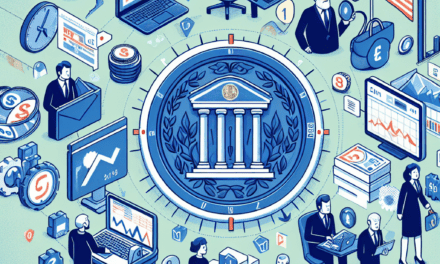“Forecasting the Future: How Economic Indicators and Weather-Related Job Data Shape Fed Decisions.”
Introduction
Economic indicators and weather-related job data are pivotal in shaping the decisions made during Federal Reserve meetings. Economic indicators, such as GDP growth rates, unemployment figures, inflation rates, and consumer spending, provide a comprehensive overview of the current economic landscape. These metrics help the Fed assess the health of the economy and determine appropriate monetary policy actions. Meanwhile, weather-related job data, which includes employment fluctuations due to seasonal weather patterns or extreme weather events, offers insights into temporary disruptions or boosts in specific sectors like agriculture, construction, and retail. By analyzing these data points, the Federal Reserve can better understand short-term economic volatility and long-term trends, allowing for more informed decisions regarding interest rates and other monetary policies. As the Fed prepares for its upcoming meeting, the interplay between these economic indicators and weather-related job data will be crucial in guiding its policy direction to ensure economic stability and growth.
Analyzing the Impact of Weather-Related Job Data on Economic Indicators
As the Federal Reserve prepares for its upcoming meeting, the interplay between economic indicators and weather-related job data has garnered significant attention. Understanding this relationship is crucial, as it provides insights into the broader economic landscape and informs monetary policy decisions. Recent fluctuations in employment figures, particularly those influenced by weather conditions, have added a layer of complexity to the economic outlook. Consequently, the Federal Reserve must carefully consider these variables to make informed decisions that will steer the economy toward stability and growth.
Weather-related job data often presents a unique challenge in economic analysis. Seasonal variations, such as harsh winters or severe storms, can temporarily disrupt employment in sectors like construction, agriculture, and retail. These disruptions, while often short-lived, can skew monthly employment reports, leading to potential misinterpretations of the underlying economic trends. For instance, a sudden drop in construction jobs during a particularly harsh winter may not necessarily indicate a downturn in the housing market but rather a temporary pause in activity. Therefore, it is essential for policymakers to distinguish between short-term weather-induced fluctuations and long-term economic shifts.
In recent months, the United States has experienced a series of extreme weather events, ranging from hurricanes in the Southeast to wildfires in the West. These events have had a tangible impact on employment figures, as businesses in affected areas have faced temporary closures and disruptions. As a result, the latest job reports have shown unexpected variances, prompting economists to delve deeper into the data to extract meaningful insights. By analyzing these figures in conjunction with other economic indicators, such as GDP growth, consumer spending, and inflation rates, the Federal Reserve can better assess the overall health of the economy.
Moreover, the influence of weather-related job data extends beyond immediate employment figures. It also affects consumer confidence and spending patterns, which are critical components of economic growth. For example, severe weather can lead to increased spending on home repairs and emergency supplies, temporarily boosting retail sales. However, it can also deter consumers from making discretionary purchases, thereby impacting sectors like travel and entertainment. Understanding these dynamics is vital for the Federal Reserve as it evaluates the broader economic environment and considers potential adjustments to interest rates.
In addition to weather-related factors, the Federal Reserve must also weigh other economic indicators that provide a comprehensive view of the economy. Inflation, for instance, remains a key concern, as rising prices can erode purchasing power and dampen economic growth. The interplay between inflation and employment is particularly significant, as wage growth can contribute to inflationary pressures. Therefore, the Federal Reserve must strike a delicate balance between fostering job growth and maintaining price stability.
As the upcoming Federal Reserve meeting approaches, the integration of weather-related job data into the broader economic analysis will be crucial. By considering these factors alongside traditional economic indicators, policymakers can develop a more nuanced understanding of the current economic landscape. This comprehensive approach will enable the Federal Reserve to make informed decisions that support sustainable economic growth while mitigating potential risks. Ultimately, the careful consideration of weather-related job data and its impact on economic indicators will play a pivotal role in shaping the Federal Reserve’s monetary policy and guiding the economy toward a stable and prosperous future.
How Seasonal Employment Trends Affect Federal Reserve Decisions
As the Federal Reserve prepares for its upcoming meeting, a confluence of economic indicators and weather-related job data is poised to play a pivotal role in shaping monetary policy decisions. The interplay between seasonal employment trends and the broader economic landscape is a critical factor that the Fed must consider to ensure that its policies are both responsive and effective. Understanding how these elements interact provides valuable insights into the complexities of economic forecasting and policy formulation.
Seasonal employment trends, particularly those influenced by weather patterns, have long been a significant component of the labor market. Industries such as agriculture, construction, and retail are especially susceptible to seasonal fluctuations, which can lead to temporary spikes or dips in employment figures. For instance, the agricultural sector often sees increased hiring during planting and harvest seasons, while the construction industry may experience slowdowns during harsh winter months. These variations can create distortions in monthly employment data, making it challenging to discern underlying trends.
The Federal Reserve, tasked with maintaining economic stability, must carefully analyze these seasonal patterns to avoid overreacting to temporary changes in employment figures. To do so, the Fed relies on a range of economic indicators, including the Bureau of Labor Statistics’ seasonal adjustment process, which aims to filter out predictable seasonal effects. However, even with these adjustments, unexpected weather events, such as hurricanes or unseasonal temperature shifts, can introduce additional volatility into the data.
In recent years, climate change has further complicated the relationship between weather and employment. Unpredictable weather patterns have led to more frequent and severe weather events, which can disrupt economic activity and labor markets. For example, prolonged droughts can impact agricultural output and employment, while severe storms can halt construction projects and affect retail sales. These disruptions can have ripple effects throughout the economy, influencing consumer spending, business investment, and ultimately, economic growth.
As the Fed evaluates its monetary policy stance, it must weigh the impact of these weather-related employment fluctuations against other economic indicators, such as inflation and GDP growth. The challenge lies in distinguishing between short-term disruptions and long-term trends. A temporary weather-related dip in employment might not warrant a change in interest rates, but a sustained pattern of weather-induced economic instability could necessitate a more proactive approach.
Moreover, the Fed’s decisions are not made in isolation. They are influenced by a broader context that includes global economic conditions, fiscal policy, and geopolitical developments. In this interconnected environment, the Fed must consider how its actions might affect, and be affected by, external factors. For instance, a decision to raise interest rates in response to domestic inflationary pressures could have implications for international trade and capital flows.
In conclusion, as the Federal Reserve approaches its upcoming meeting, the interplay between seasonal employment trends and weather-related job data will be a crucial consideration. By carefully analyzing these factors, the Fed aims to craft policies that support economic stability and growth. The challenge lies in navigating the complexities of an ever-changing economic landscape, where weather patterns and employment trends intersect with a myriad of other influences. Through a nuanced understanding of these dynamics, the Fed seeks to fulfill its mandate of promoting maximum employment and stable prices, ensuring a resilient and robust economy.
The Role of Climate Patterns in Shaping Economic Forecasts
As the Federal Reserve prepares for its upcoming meeting, the interplay between economic indicators and weather-related job data is poised to play a significant role in shaping monetary policy decisions. Traditionally, the Federal Reserve has relied on a range of economic indicators, such as employment rates, inflation, and GDP growth, to guide its policy decisions. However, in recent years, the impact of climate patterns on economic forecasts has become increasingly apparent, prompting a more nuanced approach to economic analysis.
One of the primary ways in which climate patterns influence economic forecasts is through their impact on employment data. For instance, extreme weather events, such as hurricanes, floods, and wildfires, can lead to significant disruptions in various sectors, particularly agriculture, construction, and transportation. These disruptions often result in temporary job losses, which can skew employment data and complicate the Federal Reserve’s assessment of the labor market’s health. Consequently, policymakers must consider the extent to which weather-related factors have influenced recent job data when evaluating the overall economic landscape.
Moreover, climate patterns can also affect consumer behavior and spending, which are critical components of economic growth. For example, unseasonably warm or cold weather can alter consumer demand for certain goods and services, such as heating and cooling products or seasonal clothing. These shifts in consumer behavior can lead to fluctuations in retail sales and other economic indicators, further complicating the Federal Reserve’s task of accurately assessing the economy’s trajectory. As a result, understanding the underlying climate-related factors that drive these changes is essential for making informed policy decisions.
In addition to their direct impact on employment and consumer behavior, climate patterns can also have broader implications for economic stability. For instance, prolonged droughts or severe storms can disrupt supply chains, leading to increased costs for businesses and consumers alike. These disruptions can contribute to inflationary pressures, which are a key concern for the Federal Reserve as it seeks to maintain price stability. By incorporating climate-related data into their economic models, policymakers can better anticipate potential inflationary trends and adjust their strategies accordingly.
Furthermore, the growing recognition of climate change as a long-term economic risk has prompted the Federal Reserve to consider its implications for financial stability. As climate-related events become more frequent and severe, they pose significant risks to the financial system, including potential losses for insurers, lenders, and investors. By integrating climate risk assessments into their economic forecasts, the Federal Reserve can better prepare for potential shocks to the financial system and ensure that monetary policy remains responsive to emerging challenges.
In conclusion, as the Federal Reserve approaches its upcoming meeting, the influence of climate patterns on economic forecasts cannot be overlooked. By considering the impact of weather-related job data and other climate-related factors, policymakers can gain a more comprehensive understanding of the current economic landscape and make more informed decisions. This approach not only enhances the accuracy of economic forecasts but also ensures that monetary policy remains adaptive to the evolving challenges posed by climate change. As such, the integration of climate considerations into economic analysis represents a crucial step forward in the pursuit of sustainable economic growth and stability.
Weather-Driven Job Market Fluctuations and Their Economic Implications

As the Federal Reserve prepares for its upcoming meeting, a confluence of economic indicators and weather-related job data is poised to play a pivotal role in shaping monetary policy decisions. The intricate relationship between weather patterns and employment figures has garnered increasing attention from economists and policymakers alike, as climate variability continues to exert a significant influence on labor markets. Understanding these dynamics is crucial for the Federal Reserve as it seeks to balance its dual mandate of promoting maximum employment and maintaining price stability.
Recent data has highlighted the profound impact of weather events on job markets, particularly in sectors such as agriculture, construction, and retail. For instance, unseasonably warm temperatures can extend the construction season, leading to a temporary boost in employment figures. Conversely, severe weather events such as hurricanes or blizzards can disrupt economic activity, resulting in job losses or reduced working hours. These fluctuations, while often temporary, can complicate the interpretation of employment data, making it challenging to discern underlying economic trends.
Moreover, the increasing frequency and intensity of extreme weather events, attributed in part to climate change, have amplified these effects. As a result, the Federal Reserve must consider not only the immediate impacts of weather-related disruptions but also their long-term implications for economic stability. This necessitates a nuanced approach to monetary policy, one that accounts for the volatility introduced by climate variability while remaining focused on broader economic objectives.
In addition to weather-related job data, other economic indicators are also under scrutiny as the Federal Reserve evaluates its policy stance. Inflation rates, consumer spending, and GDP growth are all critical factors that influence the central bank’s decisions. However, the interplay between these indicators and weather-driven job market fluctuations adds a layer of complexity to the analysis. For example, a temporary spike in employment due to favorable weather conditions might mask underlying weaknesses in the economy, leading to potential missteps in policy formulation.
To navigate these challenges, the Federal Reserve relies on a comprehensive assessment of economic conditions, drawing on a wide array of data sources and analytical tools. This includes sophisticated models that incorporate weather variables into economic forecasts, allowing policymakers to better anticipate the effects of climate-related disruptions. By integrating these insights into their decision-making process, the Federal Reserve aims to craft policies that are responsive to both short-term fluctuations and long-term economic trends.
As the upcoming meeting approaches, the Federal Reserve faces the delicate task of interpreting a complex economic landscape shaped by both traditional indicators and emerging weather-related factors. The decisions made in this context will have far-reaching implications, influencing not only the trajectory of the U.S. economy but also the livelihoods of millions of Americans. In this environment, clear communication and transparency are paramount, as they help to manage expectations and foster confidence among market participants.
In conclusion, the intersection of economic indicators and weather-related job data presents both challenges and opportunities for the Federal Reserve as it seeks to fulfill its mandate. By acknowledging the influence of climate variability on labor markets and incorporating this understanding into its policy framework, the central bank can better navigate the uncertainties of the modern economic landscape. As such, the upcoming meeting will serve as a critical juncture in the ongoing effort to balance economic growth with stability in an increasingly unpredictable world.
Predicting Federal Reserve Actions Based on Weather-Influenced Employment Data
As the Federal Reserve prepares for its upcoming meeting, a confluence of economic indicators and weather-related job data is poised to play a pivotal role in shaping monetary policy decisions. Traditionally, the Federal Reserve relies on a variety of economic metrics, such as inflation rates, unemployment figures, and GDP growth, to guide its policy actions. However, recent trends suggest that weather-related employment data is becoming an increasingly significant factor in these deliberations. This shift underscores the complex interplay between environmental conditions and economic performance, highlighting the need for a nuanced approach to policy-making.
To begin with, it is essential to understand how weather patterns can influence employment data. Seasonal fluctuations, such as those seen in agriculture, construction, and retail sectors, are often directly impacted by weather conditions. For instance, unseasonably warm winters can lead to increased construction activity, while severe storms may disrupt agricultural output and supply chains. Consequently, these weather-induced variations can create anomalies in employment statistics, complicating the Federal Reserve’s task of accurately assessing the labor market’s health.
Moreover, the increasing frequency and intensity of extreme weather events, attributed to climate change, have further amplified these effects. Hurricanes, wildfires, and floods not only cause immediate disruptions but also have long-term economic repercussions. They can lead to job losses in affected areas, necessitating federal aid and insurance payouts, which in turn influence consumer spending and business investment. As a result, the Federal Reserve must consider these factors when evaluating the broader economic landscape.
In recent months, the United States has experienced a series of significant weather events that have had a noticeable impact on employment data. For example, the aftermath of hurricanes in the southeastern states has led to temporary job losses in sectors such as hospitality and retail. Similarly, prolonged drought conditions in the western regions have affected agricultural employment, with ripple effects felt across related industries. These developments have introduced volatility into the labor market, complicating the Federal Reserve’s efforts to gauge the underlying strength of the economy.
Given these challenges, the Federal Reserve is likely to adopt a cautious approach in its upcoming meeting. Policymakers will need to carefully dissect the employment data to distinguish between temporary weather-related disruptions and more persistent economic trends. This task is further complicated by the ongoing recovery from the COVID-19 pandemic, which has already introduced significant uncertainty into labor market dynamics.
In light of these considerations, the Federal Reserve may opt to maintain its current monetary policy stance, emphasizing a data-driven approach that allows for flexibility in response to evolving conditions. By doing so, the central bank can ensure that it remains responsive to both short-term fluctuations and long-term economic trends. Additionally, the Federal Reserve may signal its intention to closely monitor weather-related developments and their impact on employment, underscoring the importance of adaptive policy-making in an era of increasing environmental volatility.
In conclusion, as the Federal Reserve prepares for its upcoming meeting, the influence of weather-related job data on economic indicators cannot be overstated. The interplay between environmental conditions and employment statistics presents a complex challenge for policymakers, necessitating a careful and nuanced approach. By considering these factors alongside traditional economic metrics, the Federal Reserve can better navigate the uncertainties of the current economic landscape, ensuring that its policy decisions are both informed and effective.
The Interplay Between Economic Indicators and Weather-Related Job Statistics
As the Federal Reserve prepares for its upcoming meeting, the interplay between economic indicators and weather-related job statistics is poised to play a significant role in shaping monetary policy decisions. Economic indicators, such as employment rates, inflation, and GDP growth, traditionally serve as the backbone for the Federal Reserve’s policy considerations. However, the increasing frequency and intensity of weather-related events have introduced a new variable into the economic equation, necessitating a more nuanced analysis of job data.
To begin with, employment statistics are a critical component of economic indicators, providing insights into the health of the labor market. Typically, the Federal Reserve examines these statistics to gauge economic stability and to determine whether adjustments to interest rates are necessary. However, recent trends have shown that weather-related disruptions can significantly skew these figures. For instance, hurricanes, wildfires, and severe storms can lead to temporary job losses in affected regions, complicating the interpretation of employment data. Consequently, the Federal Reserve must now consider the extent to which these weather-related events impact job statistics, distinguishing between temporary disruptions and long-term economic shifts.
Moreover, inflation is another key economic indicator that the Federal Reserve closely monitors. Weather-related events can influence inflationary pressures by disrupting supply chains and affecting the availability of goods and services. For example, a severe drought can lead to reduced agricultural output, driving up food prices and contributing to inflation. Similarly, hurricanes can damage infrastructure, leading to increased costs for repairs and reconstruction. These factors can create short-term inflationary spikes, which the Federal Reserve must carefully evaluate to avoid overreacting to what may be temporary price increases.
In addition to employment and inflation, GDP growth is a fundamental economic indicator that reflects the overall economic performance of a country. Weather-related events can have a dual impact on GDP growth. On one hand, they can hinder economic activity by causing disruptions in production and consumption. On the other hand, the subsequent recovery efforts, such as rebuilding and infrastructure improvements, can stimulate economic growth. Therefore, the Federal Reserve must assess the net effect of these events on GDP growth, considering both the immediate negative impacts and the potential for longer-term economic benefits.
Furthermore, the Federal Reserve’s task is complicated by the unpredictability of weather-related events. Unlike traditional economic indicators, which can be forecasted with a degree of certainty, weather patterns are inherently volatile. This unpredictability necessitates a flexible approach to monetary policy, allowing the Federal Reserve to respond swiftly to unforeseen disruptions while maintaining a focus on long-term economic stability.
In conclusion, the interplay between economic indicators and weather-related job statistics presents a complex challenge for the Federal Reserve as it prepares for its upcoming meeting. By carefully analyzing the impact of weather-related events on employment, inflation, and GDP growth, the Federal Reserve can make informed decisions that balance short-term economic fluctuations with long-term policy objectives. As weather-related disruptions become more frequent, the integration of these considerations into monetary policy will be essential for maintaining economic resilience in the face of an ever-changing climate landscape.
Understanding the Federal Reserve’s Response to Climate-Related Economic Changes
As the Federal Reserve prepares for its upcoming meeting, the intersection of economic indicators and weather-related job data has become a focal point for policymakers. The central bank’s mandate to ensure maximum employment and stable prices is increasingly influenced by climate-related economic changes, which are reshaping traditional economic models. Understanding how these factors interplay is crucial for anticipating the Fed’s response and its potential impact on the broader economy.
Recent economic data has highlighted the growing influence of climate events on employment figures. For instance, severe weather conditions, such as hurricanes and wildfires, have led to temporary disruptions in various sectors, notably agriculture, construction, and tourism. These disruptions are reflected in job data, where sudden spikes in unemployment claims or fluctuations in job creation numbers can be traced back to climate-related incidents. Consequently, the Federal Reserve must consider these anomalies when assessing the overall health of the labor market.
Moreover, the impact of climate change extends beyond immediate job losses. It also affects long-term economic productivity and growth. For example, prolonged droughts can lead to reduced agricultural output, while rising sea levels threaten infrastructure and real estate in coastal areas. These factors contribute to shifts in economic activity and resource allocation, necessitating a nuanced approach from the Fed in its policy decisions. By incorporating climate-related data into their analyses, policymakers can better gauge the underlying trends in the economy and adjust their strategies accordingly.
In addition to employment data, other economic indicators are also being influenced by climate change. Inflation, a key concern for the Federal Reserve, can be affected by climate-related supply chain disruptions. For instance, extreme weather events can lead to shortages in essential goods, driving up prices and contributing to inflationary pressures. The Fed must carefully balance these inflationary risks with its goal of supporting economic growth, particularly in a post-pandemic recovery phase.
Furthermore, the transition to a more sustainable economy presents both challenges and opportunities for the Federal Reserve. As industries adapt to new environmental regulations and consumer preferences shift towards greener products, there is potential for job creation in emerging sectors such as renewable energy and sustainable agriculture. However, this transition also poses risks, particularly for regions and industries heavily reliant on fossil fuels. The Fed’s role in facilitating a smooth transition while maintaining economic stability is critical.
In light of these complexities, the Federal Reserve’s upcoming meeting will likely focus on integrating climate-related data into its economic assessments. This approach aligns with a broader trend among central banks worldwide, recognizing the importance of climate change as a systemic risk to financial stability. By considering the multifaceted impacts of climate change on the economy, the Fed can develop more informed and effective monetary policies.
Ultimately, the Federal Reserve’s response to climate-related economic changes will have significant implications for businesses, consumers, and investors. As the central bank navigates this evolving landscape, its decisions will shape the trajectory of the U.S. economy in the face of ongoing environmental challenges. By understanding the interplay between economic indicators and weather-related job data, stakeholders can better anticipate the Fed’s actions and their potential effects on the economic environment.
Q&A
1. **Question:** How do economic indicators like GDP growth influence Federal Reserve decisions?
– **Answer:** GDP growth is a key indicator of economic health. Strong growth may lead the Fed to raise interest rates to prevent inflation, while weak growth might prompt rate cuts to stimulate the economy.
2. **Question:** What role does the unemployment rate play in Fed policy decisions?
– **Answer:** A low unemployment rate suggests a strong labor market, potentially leading to inflationary pressures, prompting the Fed to consider raising interest rates. Conversely, high unemployment may lead to rate cuts to encourage job creation.
3. **Question:** How can weather-related job data impact the Fed’s economic outlook?
– **Answer:** Severe weather can disrupt employment in sectors like agriculture and construction, leading to temporary job losses. The Fed may look past short-term weather impacts if underlying economic conditions remain stable.
4. **Question:** In what way does inflation data affect the Federal Reserve’s interest rate decisions?
– **Answer:** High inflation may lead the Fed to increase interest rates to cool down the economy, while low inflation might result in rate cuts to encourage spending and investment.
5. **Question:** How does consumer spending data influence the Fed’s monetary policy?
– **Answer:** Strong consumer spending indicates economic confidence and growth, potentially leading to higher interest rates to prevent overheating. Weak spending might prompt rate cuts to boost economic activity.
6. **Question:** What is the significance of the Federal Reserve’s dual mandate in its decision-making process?
– **Answer:** The Fed’s dual mandate is to achieve maximum employment and stable prices. Decisions are influenced by how economic indicators align with these goals, balancing between controlling inflation and supporting job growth.
7. **Question:** How might unexpected weather events alter the Fed’s economic forecasts?
– **Answer:** Unexpected weather events can cause short-term disruptions in economic activity, leading the Fed to adjust forecasts. However, they typically focus on long-term trends unless weather impacts are severe and prolonged.
Conclusion
Economic indicators and weather-related job data are crucial in shaping the Federal Reserve’s monetary policy decisions. Economic indicators such as GDP growth, inflation rates, and employment figures provide insights into the overall health of the economy. Weather-related job data, particularly in sectors like agriculture and construction, can significantly impact employment statistics and economic output. Adverse weather conditions can lead to temporary job losses or reduced productivity, influencing short-term economic performance. As the Federal Reserve aims to balance economic growth with inflation control, these data points help assess whether to adjust interest rates or implement other monetary measures. In the upcoming Fed meeting, the interplay between robust economic indicators and any weather-induced job fluctuations will be pivotal in determining the direction of monetary policy, ensuring it aligns with the dual mandate of promoting maximum employment and stable prices.





